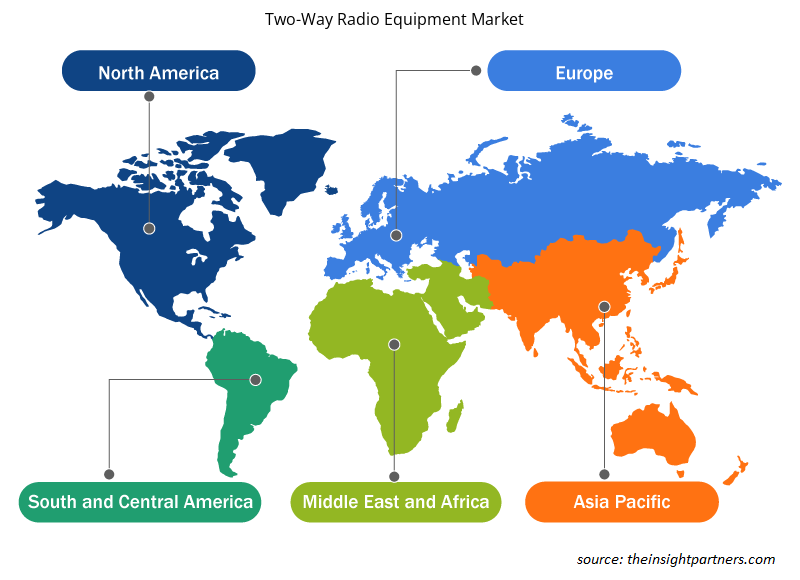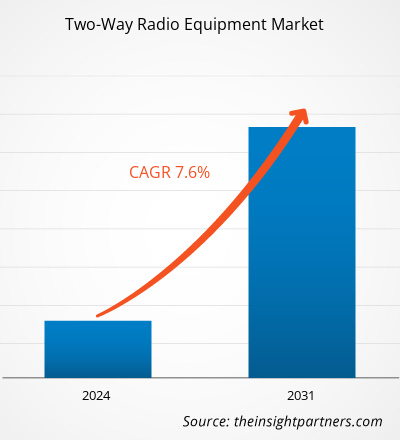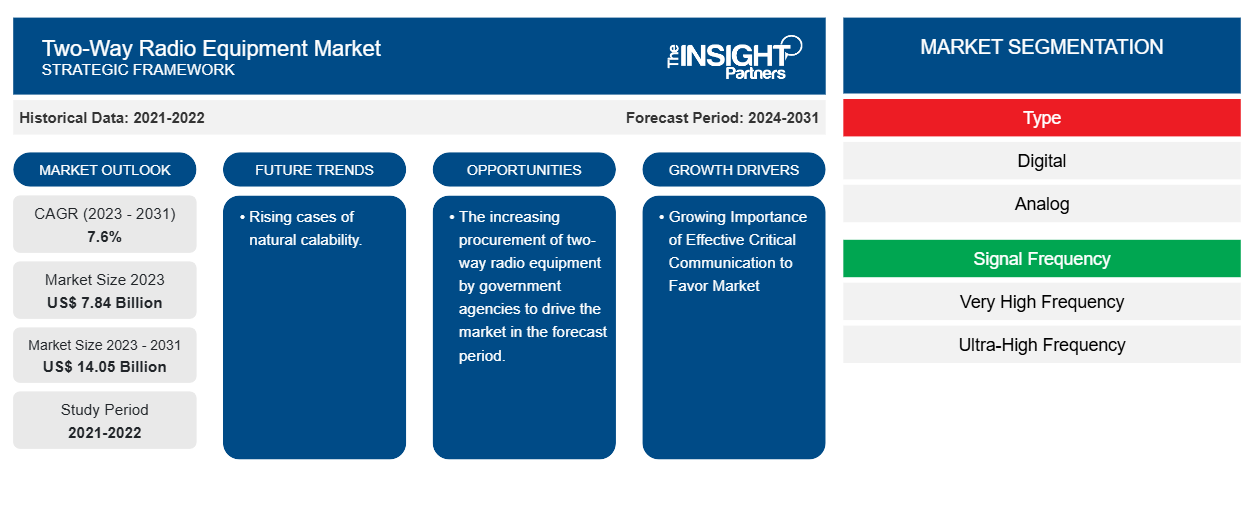Le marché des équipements radio bidirectionnels devrait atteindre 14,05 milliards USD d'ici 2031, contre 7,84 milliards USD en 2023. Le marché devrait enregistrer un TCAC de 7,6 % au cours de la période 2023-2031. L'adoption croissante de la radio bidirectionnelle numérique par rapport aux équipements analogiques et la demande croissante d'équipements radio bidirectionnels dans la fabrication de capteurs sont susceptibles d'être les principaux moteurs et tendances du marché.
Analyse du marché des équipements radio bidirectionnels
Le marché des équipements radio bidirectionnels connaît une croissance significative à l'échelle mondiale. Cette croissance est attribuée à des facteurs tels que l'adoption croissante de la radio bidirectionnelle numérique par rapport aux équipements analogiques et la demande croissante d'équipements radio bidirectionnels dans la fabrication de capteurs. De plus, l'augmentation des achats d'équipements radio bidirectionnels par les agences gouvernementales devrait stimuler la croissance du marché dans les années à venir.
Aperçu du marché des équipements radio bidirectionnels
Une radio bidirectionnelle est considérée comme un émetteur-récepteur radio. Cette radio peut à la fois communiquer et recevoir des ondes radio, ce qui est utilisé pour la communication vocale bidirectionnelle de personne à personne avec d'autres utilisateurs disposant de radios similaires, contrairement à un récepteur de radiodiffusion, qui ne reçoit que des transmissions. Les radios bidirectionnelles utilisent généralement un canal de communication semi-duplex, qui autorise la communication bidirectionnelle, même si elle est limitée au fait qu'un seul utilisateur peut transmettre à la fois.
Personnalisez ce rapport en fonction de vos besoins
Vous bénéficierez d'une personnalisation gratuite de n'importe quel rapport, y compris de certaines parties de ce rapport, d'une analyse au niveau des pays, d'un pack de données Excel, ainsi que de superbes offres et réductions pour les start-ups et les universités.
-
Obtenez les principales tendances clés du marché de ce rapport.Cet échantillon GRATUIT comprendra une analyse de données, allant des tendances du marché aux estimations et prévisions.
Moteurs et opportunités du marché des équipements radio bidirectionnels
Importance croissante d’une communication critique efficace pour favoriser le marché.
L'importance croissante d'une communication critique efficace stimule en effet le marché. La technologie radio bidirectionnelle a évolué de la voix analogique traditionnelle à des systèmes complexes avec des capacités de partage de ressources et numériques qui permettent des fonctionnalités telles que les appels de groupe, la configuration rapide des appels vocaux, un son de haute qualité et un accès prioritaire garanti à l'utilisateur final. Avec l'augmentation de la criminalité, du terrorisme et des catastrophes naturelles, les industries sont obligées d'adopter de nouvelles technologies pour permettre des réactions rapides et efficaces en temps réel. Une communication efficace est essentielle pour les intervenants de la sécurité publique qui doivent rester connectés au centre de contrôle tout en acquérant des informations situationnelles en temps réel lorsqu'ils réagissent aux situations.
Augmentation des cas de catastrophes naturelles.
L’augmentation du nombre de catastrophes naturelles, notamment les ouragans, les tremblements de terre, les incendies de forêt et les inondations, a considérablement accru la demande de systèmes de voix fiables, agissant ainsi comme un moteur pour le marché des équipements radio bidirectionnels. En septembre 2023, selon la National Oceanic and Atmospheric Administration, les États-Unis ont subi 23 énormes catastrophes météorologiques et climatiques distinctes, chacune ayant entraîné au moins 1 milliard de dollars de dégâts. Lors de telles catastrophes naturelles, les infrastructures de communication traditionnelles telles que les réseaux cellulaires et la connectivité Internet peuvent souvent être perturbées en raison d’infrastructures endommagées ou d’une surcharge. Dans de telles situations, les intervenants d’urgence, les agences gouvernementales et les organisations de secours s’appuient fortement sur la radio bidirectionnelle pour les communications critiques, car elles offrent des capacités de communication robustes et résilientes.
Analyse de segmentation du rapport sur le marché des équipements radio bidirectionnels
Les segments clés qui ont contribué à l’élaboration de l’analyse du marché des équipements radio bidirectionnels sont le type, la fréquence du signal et l’industrie d’utilisation finale.
- Selon le type, le marché des équipements radio bidirectionnels est divisé en numérique et analogique. Le segment numérique devrait détenir une part de marché importante au cours de la période de prévision.
- En fonction de la fréquence du signal, le marché des équipements radio bidirectionnels est divisé en très haute fréquence (VHF) et ultra-haute fréquence (UHF). Le segment très haute fréquence (VHF) devrait détenir une part de marché importante au cours de la période de prévision.
- En fonction de l'industrie d'utilisation finale , le marché est segmenté en secteurs public et de sécurité publique, fabrication, services publics, transport et logistique, éducation, hôtellerie et autres. Le secteur public et de la sécurité publique devrait détenir une part de marché importante au cours de la période de prévision.
Analyse des parts de marché des équipements radio bidirectionnels par géographie
La portée géographique du rapport sur le marché des équipements radio bidirectionnels est principalement divisée en cinq régions : Amérique du Nord, Asie-Pacifique, Europe, Moyen-Orient et Afrique, et Amérique du Sud et centrale.
L'Amérique du Nord domine le marché des équipements radio bidirectionnels. Les tendances d'adoption de haute technologie dans diverses industries de la région nord-américaine ont alimenté la croissance du marché des équipements radio bidirectionnels. Des facteurs tels que l'adoption accrue d'outils numériques et les dépenses technologiques élevées des agences gouvernementales devraient stimuler la croissance du marché nord-américain des équipements radio bidirectionnels. L'adoption croissante de la radio bidirectionnelle numérique par rapport aux équipements analogiques et la demande croissante d'équipements radio bidirectionnels dans la fabrication de capteurs. De plus, l'accent mis sur la recherche et le développement dans les économies développées des États-Unis et du Canada oblige les acteurs nord-américains à apporter des solutions technologiquement avancées sur le marché. En outre, les États-Unis comptent un grand nombre d'acteurs du marché des équipements radio bidirectionnels qui se concentrent de plus en plus sur le développement de solutions innovantes. Tous ces facteurs contribuent à la croissance du marché des équipements radio bidirectionnels de la région.
Aperçu régional du marché des équipements radio bidirectionnels
Les tendances et facteurs régionaux influençant le marché des équipements radio bidirectionnels tout au long de la période de prévision ont été expliqués en détail par les analystes d’Insight Partners. Cette section traite également des segments et de la géographie du marché des équipements radio bidirectionnels en Amérique du Nord, en Europe, en Asie-Pacifique, au Moyen-Orient et en Afrique, ainsi qu’en Amérique du Sud et en Amérique centrale.

- Obtenez les données régionales spécifiques au marché des équipements radio bidirectionnels
Portée du rapport sur le marché des équipements radio bidirectionnels
| Attribut de rapport | Détails |
|---|---|
| Taille du marché en 2023 | 7,84 milliards de dollars américains |
| Taille du marché d'ici 2031 | 14,05 milliards de dollars américains |
| Taux de croissance annuel composé mondial (2023-2031) | 7,6% |
| Données historiques | 2021-2022 |
| Période de prévision | 2024-2031 |
| Segments couverts |
Par type
|
| Régions et pays couverts |
Amérique du Nord
|
| Leaders du marché et profils d'entreprises clés |
|
Densité des acteurs du marché des équipements radio bidirectionnels : comprendre son impact sur la dynamique commerciale
Le marché des équipements radio bidirectionnels connaît une croissance rapide, tirée par la demande croissante des utilisateurs finaux en raison de facteurs tels que l'évolution des préférences des consommateurs, les avancées technologiques et une plus grande sensibilisation aux avantages du produit. À mesure que la demande augmente, les entreprises élargissent leurs offres, innovent pour répondre aux besoins des consommateurs et capitalisent sur les tendances émergentes, ce qui alimente davantage la croissance du marché.
La densité des acteurs du marché fait référence à la répartition des entreprises ou des sociétés opérant sur un marché ou un secteur particulier. Elle indique le nombre de concurrents (acteurs du marché) présents sur un marché donné par rapport à sa taille ou à sa valeur marchande totale.
Les principales entreprises opérant sur le marché des équipements radio bidirectionnels sont :
- BK Technologies Inc.
- Groupe Bearcom Inc.
- Société de communications Hytera Ltée
- Icom Amérique Inc.
- Société de radio Midland
- Motorola Solutions Inc.
Avis de non-responsabilité : les sociétés répertoriées ci-dessus ne sont pas classées dans un ordre particulier.

- Obtenez un aperçu des principaux acteurs du marché des équipements radio bidirectionnels
Actualités et développements récents du marché des équipements radio bidirectionnels
Le marché des équipements radio bidirectionnels est évalué en collectant des données qualitatives et quantitatives après des recherches primaires et secondaires, qui comprennent d'importantes publications d'entreprise, des données d'association et des bases de données. Quelques-uns des développements sur le marché des équipements radio bidirectionnels sont énumérés ci-dessous :
- Hytera Communications, l'un des principaux fournisseurs mondiaux de technologies et de solutions de communication professionnelles, a récemment lancé sa dernière série de radios à sécurité intrinsèque (IS), notamment la radio bidirectionnelle portable HP79XEx DMR et la radio portable TETRA PT890Ex. (Source : site Web de la société Hytera Communications, novembre 2023)
- Motorola Solutions a annoncé le lancement du MOTOTRBO R7 en Europe, au Moyen-Orient et en Afrique. La nouvelle radio bidirectionnelle numérique offre des fonctionnalités audio avancées et une conception fine et robuste pour connecter les équipes dans des environnements bruyants, difficiles et dynamiques. (Source : site Web de la société Motorola Solutions, avril 2022)
Rapport sur la couverture et les livrables du marché des équipements radio bidirectionnels
Le rapport « Taille et prévisions du marché des équipements radio bidirectionnels (2021-2031) » fournit une analyse détaillée du marché couvrant les domaines ci-dessous :
- Taille et prévisions du marché des équipements radio bidirectionnels aux niveaux mondial, régional et national pour tous les segments de marché clés couverts par le champ d'application
- Tendances du marché des équipements radio bidirectionnels ainsi que la dynamique du marché, telles que les facteurs moteurs, les contraintes et les opportunités clés
- Analyse détaillée des cinq forces de PEST/Porter et SWOT
- Analyse du marché des équipements radio bidirectionnels couvrant les principales tendances du marché, le cadre mondial et régional, les principaux acteurs, les réglementations et les développements récents du marché
- Analyse du paysage industriel et de la concurrence couvrant la concentration du marché, l'analyse de la carte thermique, les principaux acteurs et les développements récents pour le marché des équipements radio bidirectionnels
- Profils d'entreprise détaillés
- Analyse historique (2 ans), année de base, prévision (7 ans) avec TCAC
- Analyse PEST et SWOT
- Taille du marché Valeur / Volume - Mondial, Régional, Pays
- Industrie et paysage concurrentiel
- Ensemble de données Excel
Rapports récents
Rapports connexes
Témoignages
Raison d'acheter
- Prise de décision éclairée
- Compréhension de la dynamique du marché
- Analyse concurrentielle
- Connaissances clients
- Prévisions de marché
- Atténuation des risques
- Planification stratégique
- Justification des investissements
- Identification des marchés émergents
- Amélioration des stratégies marketing
- Amélioration de l'efficacité opérationnelle
- Alignement sur les tendances réglementaires























 Obtenez un échantillon gratuit pour - Marché des équipements radio bidirectionnels
Obtenez un échantillon gratuit pour - Marché des équipements radio bidirectionnels